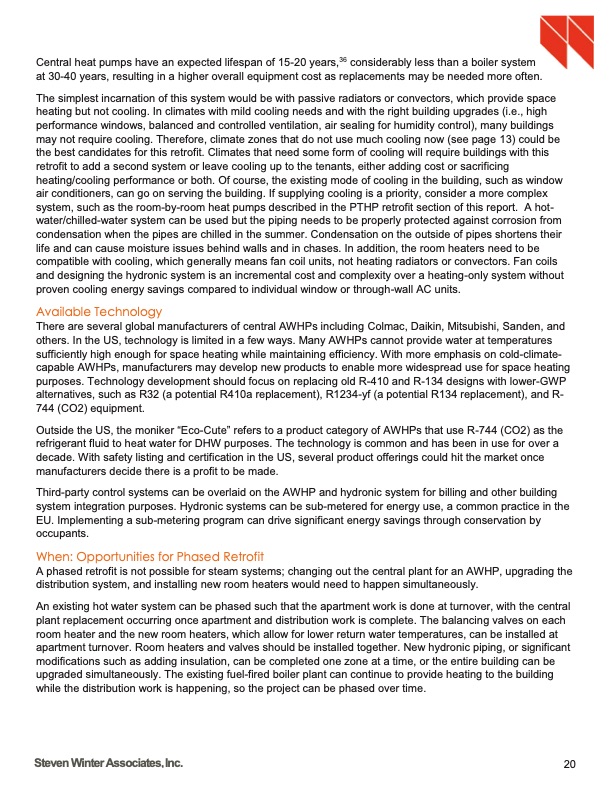
PDF Publication Title:
Text from PDF Page: 020
Central heat pumps have an expected lifespan of 15-20 years,36 considerably less than a boiler system at 30-40 years, resulting in a higher overall equipment cost as replacements may be needed more often. The simplest incarnation of this system would be with passive radiators or convectors, which provide space heating but not cooling. In climates with mild cooling needs and with the right building upgrades (i.e., high performance windows, balanced and controlled ventilation, air sealing for humidity control), many buildings may not require cooling. Therefore, climate zones that do not use much cooling now (see page 13) could be the best candidates for this retrofit. Climates that need some form of cooling will require buildings with this retrofit to add a second system or leave cooling up to the tenants, either adding cost or sacrificing heating/cooling performance or both. Of course, the existing mode of cooling in the building, such as window air conditioners, can go on serving the building. If supplying cooling is a priority, consider a more complex system, such as the room-by-room heat pumps described in the PTHP retrofit section of this report. A hot- water/chilled-water system can be used but the piping needs to be properly protected against corrosion from condensation when the pipes are chilled in the summer. Condensation on the outside of pipes shortens their life and can cause moisture issues behind walls and in chases. In addition, the room heaters need to be compatible with cooling, which generally means fan coil units, not heating radiators or convectors. Fan coils and designing the hydronic system is an incremental cost and complexity over a heating-only system without proven cooling energy savings compared to individual window or through-wall AC units. Available Technology There are several global manufacturers of central AWHPs including Colmac, Daikin, Mitsubishi, Sanden, and others. In the US, technology is limited in a few ways. Many AWHPs cannot provide water at temperatures sufficiently high enough for space heating while maintaining efficiency. With more emphasis on cold-climate- capable AWHPs, manufacturers may develop new products to enable more widespread use for space heating purposes. Technology development should focus on replacing old R-410 and R-134 designs with lower-GWP alternatives, such as R32 (a potential R410a replacement), R1234-yf (a potential R134 replacement), and R- 744 (CO2) equipment. Outside the US, the moniker “Eco-Cute” refers to a product category of AWHPs that use R-744 (CO2) as the refrigerant fluid to heat water for DHW purposes. The technology is common and has been in use for over a decade. With safety listing and certification in the US, several product offerings could hit the market once manufacturers decide there is a profit to be made. Third-party control systems can be overlaid on the AWHP and hydronic system for billing and other building system integration purposes. Hydronic systems can be sub-metered for energy use, a common practice in the EU. Implementing a sub-metering program can drive significant energy savings through conservation by occupants. When: Opportunities for Phased Retrofit A phased retrofit is not possible for steam systems; changing out the central plant for an AWHP, upgrading the distribution system, and installing new room heaters would need to happen simultaneously. An existing hot water system can be phased such that the apartment work is done at turnover, with the central plant replacement occurring once apartment and distribution work is complete. The balancing valves on each room heater and the new room heaters, which allow for lower return water temperatures, can be installed at apartment turnover. Room heaters and valves should be installed together. New hydronic piping, or significant modifications such as adding insulation, can be completed one zone at a time, or the entire building can be upgraded simultaneously. The existing fuel-fired boiler plant can continue to provide heating to the building while the distribution work is happening, so the project can be phased over time. Steven Winter Associates,Inc. 20PDF Image | HEAT PUMP RETROFIT STRATEGIES FOR MULTIFAMILY BUILDINGS

PDF Search Title:
HEAT PUMP RETROFIT STRATEGIES FOR MULTIFAMILY BUILDINGSOriginal File Name Searched:
heat-pump-retrofit-strategies-report-05082019.pdfDIY PDF Search: Google It | Yahoo | Bing
CO2 Organic Rankine Cycle Experimenter Platform The supercritical CO2 phase change system is both a heat pump and organic rankine cycle which can be used for those purposes and as a supercritical extractor for advanced subcritical and supercritical extraction technology. Uses include producing nanoparticles, precious metal CO2 extraction, lithium battery recycling, and other applications... More Info
Heat Pumps CO2 ORC Heat Pump System Platform More Info
| CONTACT TEL: 608-238-6001 Email: greg@infinityturbine.com | RSS | AMP |